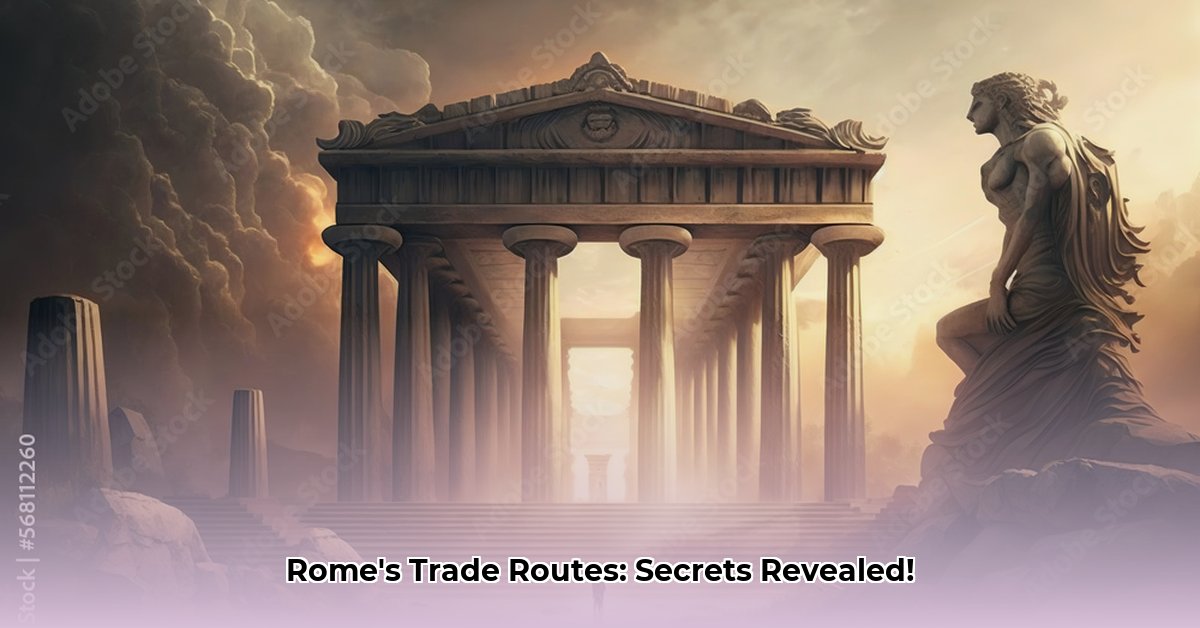Beyond the legions and monumental architecture, the true engine of the Roman Empire’s unparalleled might was its vast, intricate trade network. Far from a mere exchange of goods, this colossal system of land and sea routes acted as the very circulatory system of Roman civilization, carrying not just commodities but also wealth, influence, and cultural exchange across three continents. Forget the gladiator arenas for a moment; to truly understand Rome’s enduring dominance, we must delve into the sophisticated commercial apparatus that sustained its sprawling cities, fed its armies, and enriched its elite. This exploration reveals not only the practicalities of ancient commerce but also profound insights into economic principles that resonate even today. You can read more on the details of Roman Trade here.
Unveiling the Economic Foundations of Roman Power
The remarkable longevity and expansion of the Roman Empire were inextricably linked to its sophisticated economic system. This system, developing rapidly from the 2nd century BCE to the 2nd century CE, transcended local consumption, fostering a thriving inter-regional and even international trade. While some historians, like M.I. Finley, highlight elements of underdevelopment—such as an over-dependence on agriculture, slow technology diffusion, and low industrial investment—archaeological evidence overwhelmingly points to a dynamic economy with a significant rise in production and service industries.
At its core, Roman trade was driven by several key factors:
* Agricultural Surplus and Urban Growth: The development of an agricultural surplus allowed for population density and the emergence of massive urban centers, most notably the city of Rome, which required immense quantities of food and goods from distant provinces. With an estimated population of one million, Rome’s demand for sustenance was insatiable.
* Territorial Expansion and Military Needs: As the empire conquered new lands, it integrated them into its economic sphere. The vast Roman army, often stationed far from Rome, required a constant, reliable supply chain for provisions, equipment, and pay, making trade a strategic imperative.
* Technological Innovation and Coinage: While perhaps not as rapid as modern advancements, Roman innovations in engineering, shipbuilding, and the widespread adoption of standardized coinage (like the silver denarius and later the gold aureus) significantly facilitated commercial transactions and reduced friction in trade.
* State Control and Free Market Dynamics: A unique blend of state regulation and private enterprise characterized the Roman economy. While land ownership was highly regarded by the elite, commercial ventures offered immense wealth, prompting the rich to invest through agents known as negotiatores.
The Lifeblood of Empire: Goods and Commodities
The Roman trade system moved an astonishing variety of goods, ranging from life-sustaining staples to exotic luxuries that defined elite status.
Staple Commodities: Feeding an Empire
Grain: The cornerstone of the Roman diet, grain was imported in immense quantities. Egypt and North Africa, particularly the fertile Nile Delta, served as the empire’s breadbaskets, with ports like Alexandria exporting an estimated 150,000 tonnes of grain annually.
Wine and Olive Oil: These were not just luxuries but daily necessities, used in cooking, lighting, hygiene, and religious rituals. Highly specialized regions produced vast surpluses: wine estates in southern France could store 100,000 liters, and an olive oil factory in Libya boasted 17 presses capable of producing 100,000 liters annually. Archeological sites like Monte Testaccio in Rome, an artificial hill formed solely by discarded olive oil amphorae (specifically the Dressel 20 type), bear witness to the staggering scale, with an estimated 53 million vessels.
Salt: Critical for food preservation and seasoning, salt was transported along specialized routes like the Via Salaria, highlighting its value.
Raw Materials and Manufactured Goods
The empire was rich in natural resources, which were extensively traded and processed.
Metals: Gold (with Spanish mines producing 9,000 kilos yearly), silver, copper, tin, iron, and lead were mined across the empire, essential for coinage, tools, weapons, and construction.
Construction Materials: Marble, bricks, and wood were transported for public buildings, temples, and private residences, sourced from quarries across the empire.
Pottery and Glassware: Mass-produced pottery, including high-quality Terra Sigillata from northern Gaul, and specialized glassware from the Eastern Mediterranean, were widely distributed, as evidenced by their presence in shipwrecks and across archaeological sites.
Textiles and Leather: Animal products such as leather hides, wool, and linens from Egypt were crucial for clothing and various industrial applications.
Luxury Goods: The Allure of the Exotic
For Rome’s affluent classes, trade brought a world of exotic delights.
Silk: Primarily from China, via the Silk Road, silk was the ultimate status symbol, prompting concerns from moralists like Pliny the Elder, who famously exaggerated that the empire lost 100 million sesterces annually on Eastern luxuries.
Spices: Pepper, cinnamon, ginger, cloves, and cardamom arrived from India and Southeast Asia via Red Sea ports like Berenice and Myos Hormos, used for culinary purposes, perfumes, and medicines.
Precious Stones and Ivory: Gems and ivory, often from India and Africa, adorned jewelry and luxury items.
Purple Dye: Sourced from Tyre, this highly prized dye was a symbol of nobility and high status, reserved for imperial robes and elite garments.
Exotic Animals: Wild animals for gladiator fights and spectacles were imported from Africa.
The Network: Roads, Seas, and State Oversight
The sheer scale of Roman trade relied on an impressive infrastructure and a sophisticated organizational structure.
The Arteries of the Empire: Roads
The Romans were master road builders, constructing over 80,000 kilometers of paved roads, potentially reaching 100,000 kilometers, throughout their empire. While famous for military movements, these roads were equally vital for commerce. The Via Appia, linking Rome to Brundisium, was a critical artery for merchants traveling to Greece and the East. Other key land routes included:
* Via Aurelia: A coastal route connecting Rome to France, moving goods like wine and olive oil.
* Via Domitia: Connected Italy to Spain, facilitating the transport of silver and other mined resources.
* Via Egnatia: A major east-west route across the Balkan Peninsula to Byzantium, linking to Eastern trade.
* Via Militaris (or Via Diagonalis): Facilitated troop and goods transport between the Balkans and Eastern provinces.
Despite the celebrated roads, land transport remained significantly more expensive than sea transport, with a cost ratio of approximately 28:5:1 (land:river:sea). Wagons pulled by oxen or mules moved goods, though the cursus publicus (imperial courier system) was predominantly for official use, not commercial correspondence.
Mare Nostrum: The Maritime Superhighway
The Mediterranean Sea was truly “Mare Nostrum” (“Our Sea”), serving as the primary highway for Roman commerce. A powerful Roman navy worked to suppress piracy and ensure safe passage. Major bustling ports like Ostia (Rome’s primary entry point at the mouth of the Tiber), Puteoli (near Naples for international shipments), Alexandria (Egypt’s grain powerhouse), Carthage, and Antioch facilitated immense volumes of goods.
Analysis of over 900 Roman shipwrecks reveals typical merchant vessels carried 75 tons of goods or 1500 amphorae, with larger ships capable of transporting up to 300 tons. The Port Vendres II wreck (40s CE) notably contained cargo from at least 11 different merchants, including olive oil, wine, fish sauce, pottery, glass, and metal ingots. Maritime trade was faster (1,000 nautical miles in 9 days) but seasonal, restricted by dangerous winter storms from November to March. Harbors were equipped with lighthouses, cranes, and docking facilities for efficient unloading.
State Control vs. Private Enterprise
The Roman state played a crucial role, especially through the annona system, which regulated and guaranteed the grain supply to Rome, overriding market fluctuations. A specific official, the praefectus annonae, oversaw grain logistics and regulated shipowner associations (collegia navicularii). The state also taxed goods movements between provinces and controlled local markets (nundinae). Evidence of state control is seen in stamped goods (pottery, amphorae, bricks, metal ingots) that indicated origin, manufacturer, and guaranteed weight or purity, helping prevent fraud.
However, significant trade occurred independently. Private negotiatores invested heavily in shipping, warehouses, and land, often amassing vast fortunes and even gaining equestrian status (equites). Banking, though largely local, allowed merchants to take out loans in one port and repay them in another. Laws like the lex Claudia (218 BCE) even prohibited senators from owning large merchant ships, encouraging private merchants to manage global trade.
Global Connections: Beyond Roman Borders
Roman trade extended far beyond the empire’s administrative boundaries, connecting it with distant civilizations.
The Silk Road
Though not directly constructed by Romans, the Silk Road was an integral network linking China to the Roman Empire. Luxury goods, primarily silk, spices, and precious metals, traversed this overland route, passing through various middlemen, including the Parthian and later Sasanian Empires. Goods reached Roman-controlled Syria and Asia Minor, contributing to Rome’s insatiable demand for Eastern luxuries.
The Amber Road
This ancient route facilitated the movement of amber from the Baltic region to the Mediterranean, a prized commodity used in jewelry and decoration.
The Red Sea Trade Route
Pivotal for trade with India and the Far East, this sea-based route involved transporting goods to Red Sea ports then shipping them across the Indian Ocean. It brought spices, precious stones, and luxurious textiles to Roman markets. The Periplus of the Erythraean Sea, a Roman-era guidebook, meticulously describes these routes, goods, and ports, including Muziris in southern India.
The Danube River Route
Stretching from the Black Sea into Central Europe, this river route facilitated goods like grain, wine, and pottery, alongside military movements, defining the empire’s northern frontier and fostering trade with its neighbors.
Challenges, Decline, and Enduring Legacy
Despite its immense scale, the Roman trade network faced significant challenges and ultimately entered a period of decline. Piracy, though often suppressed, remained a constant threat. The cost of defending extensive trade routes became prohibitive, especially with new threats from Germanic tribes and Sasanian Persians along land routes. Internal issues such as civil wars, hyperinflation (leading to debased coinage and loss of public confidence), and political instability in the 3rd century AD severely disrupted economic stability. Bandits preyed on merchants, and provinces became increasingly isolated.
In the later empire period, while trade in the East (stimulated by Constantinople’s founding) increased, trade in the western empire experienced a marked decline. The collapse of central government and reduced tax collection forced many regions back to localized production and direct bartering. Although trade never completely ceased, its organized, empire-wide scale gradually diminished, and the vast wealth that once flowed along its routes significantly contracted. However, recent scholarship suggests a more nuanced view, indicating that regional trade often retained resilience and continued vitality in certain areas despite broader imperial decline, challenging simplistic narratives of collapse.
The Roman Empire’s trade network stands as a testament to strategic organization, infrastructure development, and the enduring human drive for commerce. Its rise, complex mechanisms, and eventual contraction offer invaluable lessons for understanding global economic dynamics. The Roman experience underscores the critical importance of robust infrastructure, the delicate balance between state intervention and free enterprise, and the power of trade not only to accumulate wealth but also to foster cultural exchange and intertwine the destinies of disparate peoples. Even as their accounting books closed centuries ago, the echoes of Roman commerce continue to inform our understanding of global supply chains, economic resilience, and the arteries that still connect our world.










